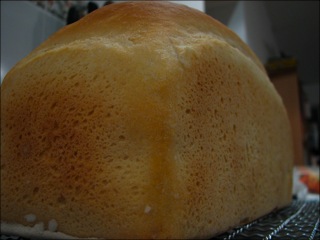Cinco de Mayo | home | Zhoug
“French” Bread
Today was a bread baking day, and I decided to try yet another new recipe. This one is from “The Bread Bible” by Beth Hensperger. ISBN 0-8118-1686-9 page 400.
One thing I noticed about the recipe is that it had nowhere near enough flour in it; I added almost a cup more than originally specified. I’ll make note of that below (showing I’m actually blind and the recipe is fine).

h2. Ingredients.
* 2.5 teaspoons of active dry yeast
* 0.5 teaspoons of sugar
* two thirds of a cup of lukewarm water
* 1 tablespoon of de-alcoholised sparkling riesling (this is my own addition and does not appear in the original recipe)
* 2.5 cups of plain flour
* 1 cup of unbleached bread flour (ARGH! this is the missing cup of flour, I completely didn’t see this when making it)
* 0.5 cups of semolina flour
* 2 teaspoons of salt
* 1 cup of cook water
* optionally, 1 egg white beaten with 1 teaspoon of water for a glaze.
h2. Method.
The original recipe made extensive use of a food processor. I chose to use my Kenwood Chef (Model A 701A, circa 1960 something), instead. Thus I’ve rewritten the method to reflect that.
In a small bowl or 2 cup jug, combine the warm water, yeast and sugar. Cover and allow to foam for 10 minutes.
In the mixer, place the flour (all except the “missing” 1 cup of bread flour), salt and semolina. Using the K-paddle (mixer paddle), turn the mixer on to low and pour in the yeast mixture and cold water. Increase the speed of the mixer to half and mix for 45 seconds or so (until smooth). Swap attachments to the dough hook and with the mixer on low (setting 1), gradually add the remaining flour. After all the flour is added and absorbed (you may need to remove the dough from the hook several times to allow the inner dough to be exposed to the fresh flour), knead on low with the dough hook for at least 10 minutes.
Once done machine kneading, remove the dough and hand knead for a minute or less until the dough is springy (it really didn’t need much at all). Form into a ball and place in a lightly greased rising bowl. Cover with cling-wrap and allow to rise.
When it’s tripled in bulk (about 1.5 to 2 hours), remove from the bowl and hand knead again to a springy state. Form into the desired loaf shape (in my case, I floured my bread tin and put the dough in that). Cover and allow to rise again until tripled in bulk. This took somewhere around 1 to 2 hours, I wasn’t paying attention. Twenty minutes before you’re ready to bake, preheat your oven to 230C (450F). When the oven is hot, reduce the temperature to 220C (425F) and put the loaf in the oven. For a whole loaf, bake for 35 to 40 minutes, then tip out on a wire rack to cool. The usual tapping of the base for a hollow sound should signify if it’s done yet.
The original recipe states you can make baguettes, bâtards, boules or petit pains from this recipe and the cooking times vary fairly widely depending on what you’re doing. I went with the boule timing for the bread tin.
Other baking times are:
2 bâtards = 25 to 30 minutes
4 baguettes = 20 to 25 minutes
8 petit pains = 18 to 24 minutes
The second rise time for the petit pains is only 15 minutes, but there are no other notes regarding rising for the other styles.
If you’re glazing your loaf, do so just before popping it in the oven. I didn’t bother, since the children don’t really care.
!/recipes/images/FrenchBread2.jpg!
Did you like this recipe? You might also like:
- Quick bread (faux turkish style)
- Corn Bread
- Potato Buttermilk Bread
- Wholemeal Rye Bread
- Wholemeal Millet Seed Bread
RSS feed for comments on this post.
Sorry, comments are closed